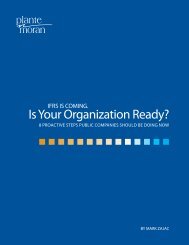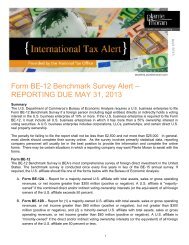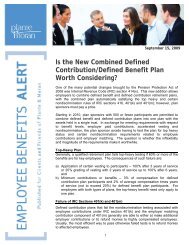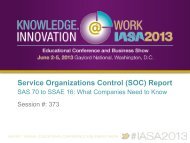{Data center.} - Plante Moran
{Data center.} - Plante Moran
{Data center.} - Plante Moran
- No tags were found...
You also want an ePaper? Increase the reach of your titles
YUMPU automatically turns print PDFs into web optimized ePapers that Google loves.
plantemoran.com{<strong>Data</strong> <strong>center</strong>. }Design standards
IT systems havebecome criticalfor the day-to-dayoperations of today’sorganizations.
{<strong>Data</strong> <strong>center</strong>.}Design standardsIT systems are critical for the day-to-day operations oftoday’s organizations. Typically, IT systems within anorganization are housed at a centralized location oftenreferred to as the “server room” or the “data <strong>center</strong>.”With many organizations experiencing continued serversprawl or a significant increase in virtual machines, thereare increased pressures on the data <strong>center</strong> in terms ofcooling, electrical, airflow, and capacity. Whether you’rebuilding a new data <strong>center</strong>, evaluating your existinginternal data <strong>center</strong>, or evaluating a hosted (commonlyreferred to as “colo”) data <strong>center</strong>, being proactive inassessing the environment and capacity of the data<strong>center</strong> can have a significant impact on the uptime,thus impacting efficiency and effectiveness of an organization’sIT operations and thus, the overall business.The availability and reliability of critical IT systems can belargely dependent upon the data <strong>center</strong>’s design andits operational and maintenance practices. Typically,the availability of a data <strong>center</strong> is measured as apercentage of uptime. Generally, uptime of 90 percentor higher is viewed as being highly available; in thecase of IT system or data <strong>center</strong> uptime, however, anythingshort of 99 percent availability due to unplannedinterruptions is considered unacceptable (see Table 1).These inadequacies prevented organizations fromresponding to outages in a timely manner. Accordingto this study, the per-incident cost of a data <strong>center</strong>outage can range between $38,969 and $1,017,746per organization depending upon the industry andsize. (Industries surveyed ranged from public sector tofinancial industries, and the costs included detection,recovery, equipment, IT and end-user productivity,third parties, lost revenue, and business disruption.)In a separate survey conducted by the ApertureResearch Institute, the primary causes for data<strong>center</strong> outages were: human error (57.3 percent),improper controls/configurations (43.7 percent),cooling issues (22.3 percent), and electrical issues(26.2 percent). When coupled with best-in-classoperational and maintenance practices, properdata <strong>center</strong> planning and design can help minimizedowntime at the data <strong>center</strong>.Standardization in the data <strong>center</strong>According to Wikipedia, a data <strong>center</strong> is defined as“a facility used to house computer systems andassociated components, such as telecommunicationsand storage systems. It generally includes redundantUptime % Est. Downtime/month Est. Downtime/year99.999% (5-9’s) 0.44 minutes 5.26 minutes99.99% (4-9’s) 4.38 minutes 52.56 minutes99.5% 39 minutes 1 day 19 hours 48 minutes99.0% 7 hours 12 minutes 3 days 15 hours 36 minutes95.0% 1 day 12 hours 0 minutes 18 days 6 hours 0 minutesTable 1According to a study conducted by the PonemonInstitute, approximately 95 percent of the surveyedorganizations experienced an unplanned data <strong>center</strong>outage that was either attributed to inadequate capacityplanning, design, or operational practices.or backup power supplies, redundant data communicationsconnections, environmental controls (e.g., airconditioning, fire suppression), and security devices.”If you looked up any definition of a data <strong>center</strong>, itwould typically contain terms such as redundancy,1
capacity, power, cooling, monitoring, controls, andsecurity. So what makes one data <strong>center</strong> different fromanother? It is the levels of redundancy, fault tolerance,and scalability provided for cooling, electrical, connectivity,the capacity for space, operational procedures inplace, and other factors. In the absence of standards, itwould be hard to compare one data <strong>center</strong> to another.Standards provide a methodology for comparingthe capabilities of one data <strong>center</strong> to another andavoiding the dangers of ambiguities or unsubstantiatedqualitative references. The Uptime Institute (TUI)provided a first attempt for standardization byusing a tiering system — a system that specifies theavailability, reliability, and capacity of a data <strong>center</strong>.As the need for data <strong>center</strong> standardization gainedmore traction, variations of these standards havearisen. Currently, there are three commonly known tiersystems: (1) Uptime Institute TUI, (2) Syska HennessyGroup, and (3) the TIA-942. A fourth standard byANSI/BICSI is also gaining some traction in this area.The TIA-942 and TUI are the more commonly referencedstandards; both provide a tier classificationsystem to help assess a site’s infrastructure. TUI andSyska Hennessy Group provide a framework for thedisciplines in a data <strong>center</strong> but lack details, whereasthe TIA-942 provides some depth into various aspectsthat go into a data <strong>center</strong>.This article focuses on the TIA-942 standard that canbe used when planning or comparing data <strong>center</strong>s.This standard can be used as the benchmark andmay be applied to a new environment, retrofitting orassessing an existing data <strong>center</strong>, or when evaluatingco-location facilities.What is the TIA-942?The TIA-942 is a data <strong>center</strong> standard developed bythe Telecommunications Industry Association (TIA); theTIA is accredited by the American National StandardsInstitute (ANSI) to develop voluntary standards forthe telecommunications industry. Also referred to asthe ANSI/TIA-942, the TIA-942 standard’s purposeis to provide design standards for a data <strong>center</strong>. Thisstandard takes multidisciplinary design approachesand addresses 20 different areas, thereby promotingcooperation between all parties involved in the designand construction of the data <strong>center</strong>. This standard maybe used to benchmark an existing internal facility or ahosted facility.Given TIA-942 standard’s roots, this standard has astrong emphasis on cabling specifications; however, italso details requirements for architectural, electrical,mechanical, security, and other site infrastructurerequirements. These 20 areas of the site infrastructurecan be broadly classified into the following seven coreareas, as shown below in Table 2.Sizing & Selection1. Design processSecurity & Protection9. Fire protectionAccess Provider & Demarcation16. Access providers2. Space planning10. Physical security17. Telecom space3. Site selection11. Building automation18. Telecom administrationTable 2Architectural & Structural4. Architectural5. Structural6. CommissioningCabling Infrastructure12. Cabinets & racks13. Cabling pathways14. Cabling systemsOperations19. Information technology(DRP, Ops Center)20. MaintenanceElectrical & Mechanical7. Electrical & grounding15. Cabling field testing8. HVAC/Mechanical systems2
Based on the criticality or dependence upon the data<strong>center</strong>, redundancy and fault tolerance need to be builtinto the site’s infrastructure. The level of redundancyand fault tolerance designed into each of these20 areas of the data <strong>center</strong>’s infrastructure determinesits tier. The TIA-942 categorizes data <strong>center</strong>s into oneof four tiers (Tiers 1 – 4), where higher tiers correspondto higher availability. Each individual area (mechanical,electrical, cabling pathways, etc.) can be assessedindependently and categorized into a tier. For example,a data <strong>center</strong> may be rated Tier 4 for its electricalcharacteristics but only Tier 3 for its mechanical characteristics.Just like the weakest link in a chain, a data<strong>center</strong>’s overall tier rating is the lowest rating across allaspects of its infrastructure. Annex G of the TIA-942standard provides the tiering requirements for each ofthese core areas.What is the differencebetween the TIA-942 andThe Uptime Institute standard?The TIA-942 was developed by ANSI, an industryassociation, whereas The Uptime Institute (TUI) isa commercial for-profit entity. The TIA-942 tieringscheme uses the TUI’s idea of a four-tiered system butprovides a prescriptive definition for each tier. TheTIA-942 classifies the tiers using quantifiable methodswhile TUI uses a functional approach. TUI’s definitionof the tiering guideline is intentionally broad to allowfor innovation in achieving the desired level of a site’sinfrastructure performance. TUI tiers evaluate data<strong>center</strong>s by their capability to allow maintenance and towithstand a system or sub-system failure. Only theTIA-942 offers a checklist form that can be used toassess the tier of a data <strong>center</strong>.The TIA-942 tiers are identified by the use of Arabicnumbers 1 through 4 (e.g., Tier 3), whereas theUptime Institute Tiers are identified by the use ofRoman numerals I through IV (e.g., Tier III). Bothstandards identify recommendations for data <strong>center</strong>design components, but the TIA-942 also coverssome operational and sustainability issues. The UTIprovides a second document (Tier Standard:Operational Sustainability) to cover operational andsustainability issues.When it comes to the certification of a data <strong>center</strong>,only the TUI offers a certification program. As of thiswriting, TUI has awarded 149 certifications worldwide,of which approximately 30 data <strong>center</strong>s are certifiedas Tier IV <strong>center</strong>s based on their design documents,constructed facility, or operational sustainability.So, when data <strong>center</strong> vendors advertise that they’re aTier IV or Tier III certified data <strong>center</strong>, be aware howrare that is. On the TIA-942 side, there’s no centralauthority that certifies data <strong>center</strong>s based on the useof the TIA-942 standard. Claims that a data <strong>center</strong>is TIA-942 Tier 4 or Tier 3 (notice the use of Arabicnumbers) certified may be based on self-assessmentor a third-party audit of the TIA-942 checklist.Both standards provide plenty of value, althougheach has a slightly different philosophy. Whenselecting a data <strong>center</strong>, it’s advisable to consider bothstandards and then select the one that best meetsyour business objectives.3
What is a data <strong>center</strong> tier classification?Both the TIA-942 and The Uptime Institute created thetier classification to consistently describe the site-levelinfrastructure required to sustain data <strong>center</strong> operations.Each individual tier represents the requirements for thedata <strong>center</strong> design; the higher the tier, the greater thesophistication of the design and operating requirements,leading to increased data <strong>center</strong> availability.Assessing the criticality of the data <strong>center</strong> to yourorganization will help identify the desired tier level ofyour data <strong>center</strong>. If you have a low level of criticality,does it make sense to invest in a Tier 3 or Tier 4 data<strong>center</strong>? Probably not. Identifying the optimal criticalityfor the organization identifies the required balancebetween a data <strong>center</strong>’s cost of ownership and thecost of downtime for the organization. Table 3 on thenext page provides the business characteristics that definecriticality and the overall effect on system design.Whatever the reason for your data <strong>center</strong> project (newbuild, retrofit, or selection of a co-location data <strong>center</strong>),it’s in your best interest to become familiar with theterminology used in the data <strong>center</strong> industry tounderstand any ambiguities that may come your way.Any project involving the data <strong>center</strong> carries risk andexpense and therefore should not be taken lightly.ConclusionThe intent of this article is to give you a brief overviewof the TIA-942 data <strong>center</strong> standard. With thisunderstanding, you will have a basis to conduct furtherresearch or to understand some of the claims made bydata <strong>center</strong> vendors. So, where do you go from here?• First, you need to perform a risk assessment todetermine hourly cost of downtime, which wouldhelp you to identify the criticality of the data<strong>center</strong> for your business.• Understand TIA-942 (requirement and process).• Assess the tier level of your current system andsub-systems.• Work with facilities to improve the overall healthof the data <strong>center</strong>.• Work with finance to justify upgrades. Alternatively,if it fits the business model, an outsourceddata <strong>center</strong> should be considered. Affordableco-location or hosted data <strong>center</strong>s and highuptime (99.995 percent) are not mutually exclusive.Navigating these requirements can be daunting.You may want to consider seeking assistance froman outside professional before you act.Judy Wright 248.223.3304judy.wright@plantemoran.comSri Chalasani 248.223.3707sri.chalasani@plantemoran.comHow can we help?Whether you need help optimizing an existing IT infrastructure, implementing a new data <strong>center</strong>, or assessinga co-location facility to meet demands, <strong>Plante</strong> <strong>Moran</strong> can help. Professionals in the IT Infrastructuregroup can assist you with:• Documenting an existing environment.• Conducting a risk assessment and/or gap analysis of a current data <strong>center</strong>.• Providing data <strong>center</strong> design and capacity planning (infrastructure, electrical, HVAC, layout, etc.).• Working with architects in new/retrofit data <strong>center</strong> builds to ensure requirements are addressed.• <strong>Data</strong> <strong>center</strong> migration management.• Vendor management.• SSAE16 (SAS70) readiness preparation and audit management.4
Criticality1 (Lowest)Business characteristics• Typically small business.• A small percentage of business revenuedepends upon availability of IT systems. IT isan enhancement to internal business processes.• Business can function without IT system orthere is low dependence upon IT.• View system downtime as a tolerableinconvenience.• Principal use of web presence is forpassive marketing.• There are no enforceable financial or non-financialpenalties due to loss of systems.Recommended <strong>Data</strong> Center TierTIER 1 - Basic Infrastructure• Non-redundant capacity components and distribution paths.Numerous single points of failure in all aspects of design.• Any capacity component or distribution path failure willimpact the computer systems.• Planned work will require most or all of the systems tobe shutdown.• Extremely vulnerable to inclement weather conditions.• Generally unable to sustain more than a 10-minutepower outage.2• Typically small to medium-sized business, mostlylimited to traditional 9-5 business hours.• A small percentage of business revenuedepends upon availability of IT systems.• Business relies upon availability of IT systems;has multiple and often inter-related systemswithin IT.• Some tolerance for downtime but extendeddowntime becomes a business deterrent.• Business does not provide real-time deliveryobligations or call <strong>center</strong>s with multiple sites.TIER 2 - Redundant Components Infrastructure• Redundant capacity components, but single non-redundantdistribution paths serving the site’s computer equipment(i.e., a distribution path failure will cause the computerequipment to shut down).• Some redundancy in power and cooling systems.• Redundant UPS modules and engine generators. Abilityto sustain a 24-hour power outage.• Minimal thought in site selection.• Formal data room separate from other areas.• There are limited financial or non-financialpenalties due to loss of systems.3• Business serves both internal and externalcustomers 24/7.• Business spans multiple time zones andcorresponding geographic diversity ofemployees and customers.TIER 3 - Concurrently Maintainable Infrastructure• Redundant capacity components and multiple distributionpaths serving the site’s computer equipment. Generally,only one distribution path serves the computer equipmentat any time.• Each and every capacity component and element of thedistribution paths can be removed from service on a plannedbasis without causing any of the computer equipment tobe shut down.• Ability to sustain a 72-hour power outage.• Careful site selection planning process.• Structure provides one-hour fire rating (how long it takesflames to penetrate the structure).Table 3• IT resources support automation ofbusiness processes.• The customer impact due to short outagesis manageable.• Business provides real-time delivery obligationsor call <strong>center</strong>s with multiple sites.• Business has significant financial exposuredue to customer quality-of-service issues.• There are financial or non-financial penaltiesdue to loss of systems.4 (Highest)• Business operates in international markets,with a “24 by forever” services commitment.• Business processes and systems operationare continuous.TIER 4 - Fault Tolerant Infrastructure• Redundant capacity systems and multiple distribution pathssimultaneously serving the site’s computer equipment,including utility power paths.• There is 2N redundancy in power and cooling systems.• Site is not susceptible to disruption of service from a singleunplanned worst-case event.• Infrastructure maintenance may be performed by usingredundant capacity components and distribution paths tosafely work on the remaining equipment.• Ability to sustain a 96-hour power outage.• Stringent site selection criteria.• Structure has a minimum two-hour fire rating.• High level of physical security systems implemented.• Availability of qualified staff to provide 24/7 onsite maintenance.• Majority of revenue comes from electronictransactions.• Business needs to react to market transactions,financial settlement, and e-commerce.• Customer or employee access to applications/IT systems provides a competitive advantage.• Extremely high cost of downtime.5
plantemoran.com










